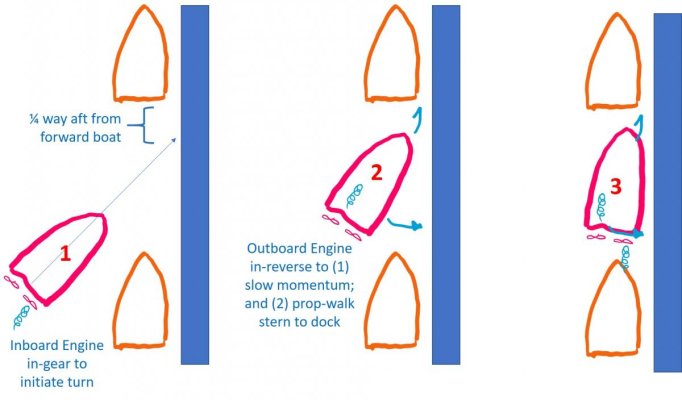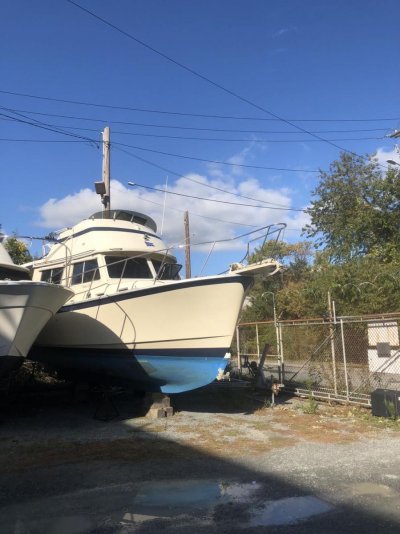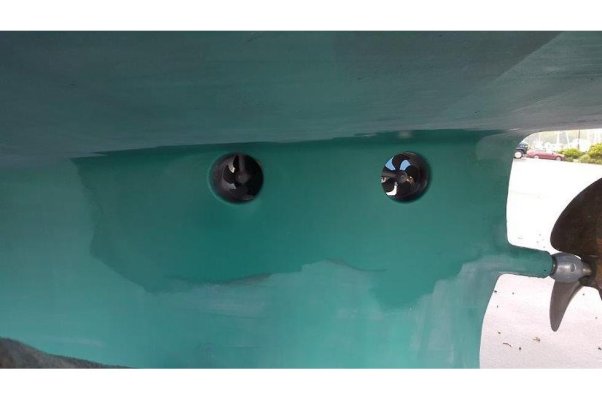mvweebles
Guru
- Joined
- Mar 21, 2019
- Messages
- 7,245
- Location
- United States
- Vessel Name
- Weebles
- Vessel Make
- 1970 Willard 36 Trawler
As rflifkin states, stern is pretty maneuverable with twins - key is to first understand prop-walk, and second, treat the two engines as two singles with opposing props. In reverse, the 'outboard' engine (the one furthest from a side-tie) will always pull the stern towards the side-tie.
I used to move a lot of boats for boat shows and such. I developed a routine that I would tweak a bit depending on how the boat moved.
1. Aim for a point about 1/4 boat length back from the boat in front. Maybe closer. As long as I was certain the slot was big enough to fit my boat, I would work to keep the boat as close to the boat in front as possible. Forward would be granted by the inboard engine (closest to dock) to initiate turn. Keep it slow. I'll repeat - crowd the boat in front and you won't have to worry about your stern swinging into the boat in back.
2. Working from the flybridge, when the dock starts to disappear due to bow-flare, drop the outboard engine in reverse. This will immediate start the stern towards the dock without rotating the bow away from the dock, and slow the boat. Feather the RPMs in reverse to modulate speed and prop-walk.
3. By this point, you have decent rotation into the dock. If your stern is swinging too fast and risks bouncing off fenders, put the inboard engine in reverse and it will immediate check rotation using prop walk. Clean-up the landing with both engines.
In Step #2, why not 'split the gears' with right engine in forward, and left engine in reverse? Because it will swing the boat away from the dock and you'll end-up several feet away from the side-tie.
If you need to extract mid-maneuver (perhaps you're worried about swinging into the boat behind you), drop the inboard engine in reverse - this will rotate your stern away from the dock and drag you away.
Leaving the berth is not quite exactly the reverse. Base move is to back-away from the side-tie. To start the rotation, I use what I call "dip the bow." A slight 'burp' of forward gear to the outboard engine to get the boat moving forward just a bit and to start the rotation away from the dock. Then the inboard in reverse - prop walk immediate pulls the stern away from the dock, and of course any forward momentum from "dipping the bow" is negated.
At least that's my process. It's worked well for me, even on large boats.
Peter

I used to move a lot of boats for boat shows and such. I developed a routine that I would tweak a bit depending on how the boat moved.
1. Aim for a point about 1/4 boat length back from the boat in front. Maybe closer. As long as I was certain the slot was big enough to fit my boat, I would work to keep the boat as close to the boat in front as possible. Forward would be granted by the inboard engine (closest to dock) to initiate turn. Keep it slow. I'll repeat - crowd the boat in front and you won't have to worry about your stern swinging into the boat in back.
2. Working from the flybridge, when the dock starts to disappear due to bow-flare, drop the outboard engine in reverse. This will immediate start the stern towards the dock without rotating the bow away from the dock, and slow the boat. Feather the RPMs in reverse to modulate speed and prop-walk.
3. By this point, you have decent rotation into the dock. If your stern is swinging too fast and risks bouncing off fenders, put the inboard engine in reverse and it will immediate check rotation using prop walk. Clean-up the landing with both engines.
In Step #2, why not 'split the gears' with right engine in forward, and left engine in reverse? Because it will swing the boat away from the dock and you'll end-up several feet away from the side-tie.
If you need to extract mid-maneuver (perhaps you're worried about swinging into the boat behind you), drop the inboard engine in reverse - this will rotate your stern away from the dock and drag you away.
Leaving the berth is not quite exactly the reverse. Base move is to back-away from the side-tie. To start the rotation, I use what I call "dip the bow." A slight 'burp' of forward gear to the outboard engine to get the boat moving forward just a bit and to start the rotation away from the dock. Then the inboard in reverse - prop walk immediate pulls the stern away from the dock, and of course any forward momentum from "dipping the bow" is negated.
At least that's my process. It's worked well for me, even on large boats.
Peter

Last edited:


